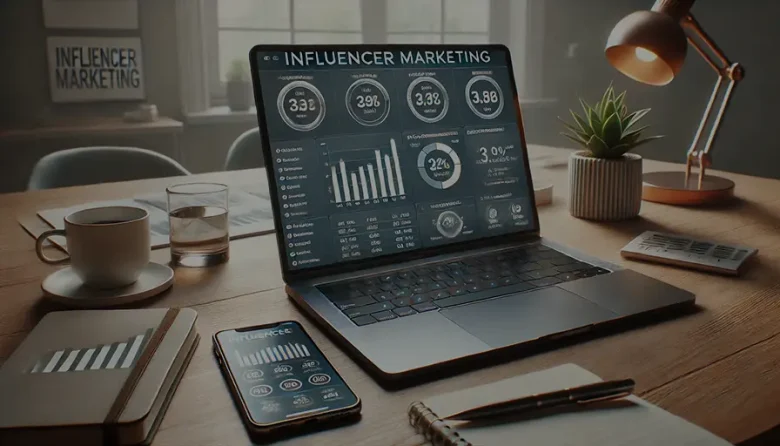Table of Contents
Data-Driven Influencer Marketing has revolutionized the way brands and content creators connect with their audiences. By combining decisions guided by accurate metrics with the authenticity of influencers, this approach transforms digital campaigns into truly impactful and measurable experiences. In this article, we will explore in depth the concepts, tools, strategies and success stories that demonstrate how the intelligent use of data can improve the results of partnerships with influencers, providing a strategic vision that combines analytical rigor with creativity.
Fundamental Concepts
What is Data-Driven Influencer Marketing?
At the heart of this approach is the intensive use of data to support all stages of an influencer campaign. Unlike traditional methods, which often relied on perceptions and intuition, the data-driven strategy prioritizes the analysis of real numbers to determine which influencers have the ideal combination of audience, engagement, and relevance for the brand. By identifying patterns and trends, companies can predict the impact of their actions, set expectations, and adjust routes quickly and assertively.
This methodology allows, for example, to identify influencers with a high level of loyalty and engagement among their followers, while also measuring the conversion potential and return on investment (ROI) of each collaboration. This makes the process more transparent and well-founded, reducing risks and maximizing results.
Key Metrics and Performance Indicators
The efficiency of Data-Driven Influencer Marketing depends directly on the monitoring of accurate metrics. Among the most commonly used indicators are:
- Reach and Impressions: Reflect the total number of people who viewed the influencer's content. These data is essential to measure the scope of a campaign.
- Engagement Rate: Calculated from interactions (likes, comments, shares) in relation to the number of followers, this metric reveals how connected the audience is with the influencer.
- Clicks and Conversions: Essential indicators to measure the direct impact on the consumer journey, highlighting how many users performed desired actions after exposure to the content.
- ROI: The relationship between the investments made and the results obtained, allowing the financial efficiency of the campaign to be assessed.
As an example, consider the analysis of a campaign carried out by a global sporting goods brand. The company measured that, by investing in influencers with a high engagement rate and targeted audience, there was a 40% increase in conversions on its e-commerce, clearly demonstrating how data can support strategic decisions.
Analysis and Monitoring Tools
Technology support is essential for executing a data-driven campaign. Several specialized platforms assist in collecting, interpreting and analyzing information. Among them: tools most used, the following stand out:
- Google Analytics: Allows you to monitor the traffic generated by influencers' actions, detailing user behavior on the brand's website.
- HypeAuditor: Provides in-depth insights into the authenticity and engagement of influencers' followers, identifying potential fraud and inactive profiles.
- Upfluence and BuzzSumo: They facilitate the research and selection of influencers, with detailed reports that help in comparing metrics and making strategic decisions.
These tools don't just optimize the choice of partners, but also enable real-time adjustments, ensuring that each action is based on concrete evidence.
Strategic Campaign Planning
Defining Objectives and Target Audience
Before implementing any campaign, it is essential to establish clear and well-defined goals. The first step is to define specific, measurable, achievable, relevant and time-bound objectives. By adopting this approach, brands can outline precise expectations, making it easier to measure the success of their actions.
Audience segmentation is also a crucial aspect. Using demographic, behavioral, and psychographic data, it is possible to identify which segments have the greatest affinity with the brand and which influencers have the ideal audience to reach them. For example, a technology company looking to promote a new gadget should prioritize influencers who work in that niche and whose followers demonstrate an interest in technological innovations.
Market Research and Benchmarking
Conducting a robust market analysis is crucial to the success of a campaign. This step involves evaluating previous campaigns and observing the strategies used by the competition. study of A very illustrative case is that of Coca-Cola, which, in a recent campaign, used data to segment its audience precisely. The brand analyzed the performance of past campaigns and incorporated successful practices, such as content personalization and integration of multiple digital platforms, resulting in a significant increase in engagement and sales.
By applying benchmarking, companies can identify opportunities for improvement and adapt strategies that have already proven effective in similar contexts. This process allows the brand to position itself competitively, leveraging valuable insights to create more targeted and efficient campaigns.
Integration with Content Optimization Strategies
While the main focus is on collaboration with influencers, integration with other content optimization practices can enhance results. Harmonizing the content created by influencers with the optimization guidelines of the brand's digital channels contributes to a better user experience. Techniques such as the appropriate use of titles, subtitles, descriptions and the visual organization of information ensure that the content is easily found and appreciated by the audience.
In a practical scenario, a luxury fashion company joined forces with influencers and simultaneously adjusted the format of its landing pages to improve the user experience. The result was a synergy that increased both the visibility and effectiveness of the campaign, demonstrating how the integration of different strategies can produce extraordinary results.
Data-Driven Influencer Selection
Criteria for Choosing the Ideal Influencer
Careful selection of influencers is essential for the campaign to reach its maximum potential. The available data allows us to evaluate several aspects, such as:
- Brand Alignment: It is crucial that the influencer’s values and personality are in line with the brand’s identity. This compatibility increases the credibility and authenticity of the messages.
- Scope and Relevance: Analyzing follower numbers and audience segmentation helps identify which influencers have the greatest potential to reach the desired target audience.
- Engagement Rate: Influencers with a high engagement rate demonstrate a deeper connection with their followers, making them partners strategic for campaigns that aim for conversion and loyalty.
- Collaboration History: Evaluating performance in previous campaigns provides a realistic view of what to expect in terms of results and return on investment.
Tools and Software for Influencer Analysis
Specialized platforms such as HypeAuditor and Upfluence play a decisive role in this process. These tools provide detailed reports that allow you to:
- Analyze the authenticity of followers and identify the presence of fake accounts.
- Compare the performance of different influencers based on standardized metrics.
- Gain insights into each influencer’s audience, enabling more precise targeting.
By leveraging these platforms, brands can create a solid foundation for decision-making, eliminating guesswork and ensuring that each partnership is grounded in hard data.
Real Examples of Successful Selection
One notable case involved a technology startup that sought to increase its market presence through strategic partnerships with influencers. By analyzing metrics such as audience engagement and relevance, the company selected influencers who, despite having a moderate number of followers, had a high conversion rate. The result was a significant increase in the adoption of the startup's products, showing that, often, the quality of the audience exceeds the quantity of followers.
Another striking example was that of a cosmetics brand, which, after reviewing its influencer portfolio using data analysis tools, identified that some partners were not delivering the expected engagement. By replacing these influencers with others with more robust metrics, the campaign achieved a 50% increase in engagement and a significant improvement in conversion rates.
Strategic Content Creation and Execution
Custom Content Development
The creation of authentic content aligned with the brand identity is a vital step in ensuring that the message is well received by the public. This phase involves defining the ideal formats – whether videos, posts, stories or live broadcasts – according to the preferences of the target audience and the characteristics of the influencer. Each format must be designed to maximize interaction and convey the message in a clear and engaging way.
A practical example can be seen in a campaign for a lifestyle brand, where influencers were invited to create videos that told their personal stories related to the product. This type of personalized approach not only strengthened the emotional connection with consumers, but also allowed for precise measurement of results, as each content was accompanied by specific viewing and interaction metrics.
Integration with Content Optimization Techniques
For the content produced to have maximum impact, it is essential that its creation takes into account aspects of organization and presentation. The use of well-structured visual elements, clarity in messages and ease of navigation are factors that, together, enhance the user experience. In many cases, the harmony between the influencer's style and the brand's visual identity creates a cohesive and attractive narrative.
In practice, a home appliance company invested in a series of explanatory videos, where influencers demonstrated the practical use of products in everyday life. By aligning these productions with the brand's design and visual language, the campaign managed not only to inform, but also to engage, reaching a wider and more diverse audience.
Real-Time Campaign Execution
Campaign implementation must be accompanied by rigorous planning, with a well-defined editorial calendar and a strategy for real-time adjustments. Continuous data collection allows brands to monitor the performance of actions and make immediate changes whenever necessary. This flexibility is essential to seize opportunities and correct possible deviations during execution.
For example, during a new product launch campaign, a healthcare company monitored daily interactions with content produced by influencers. Upon identifying a drop in engagement rates on certain days, the team responsible made adjustments to the timing and approach of posts, which resulted in a significant increase in the campaign's return.
Practical Example of Execution
In a study of In a recent case, a premium beverage brand decided to innovate by launching a campaign that included influencers from various niches – from lifestyle to gastronomy. Initially, the data indicated that certain times of day performed better in terms of engagement. Based on this analysis, the brand structured a publishing schedule that coincided with peak audience moments, thus optimizing content visibility.
In addition, the brand used monitoring tools to track metrics in real time of each publication. Based on the insights obtained, it was possible to adjust elements such as language, video length and post format, ensuring that each action was calibrated to generate maximum impact. At the end of the campaign, the results revealed a significant increase in engagement and purchase intent, reinforcing the effectiveness of data-driven execution.
Monitoring, Analysis and Optimization of Results
Data Collection and Interpretation
Monitoring results is an essential step to understanding the performance of each action and identifying areas for improvement. Creating customized dashboards and detailed reports allows responsible teams to monitor key metrics, such as views, interactions, and conversions. This detailed analysis makes it possible to identify trends, adjust strategies, and celebrate successes.
For example, an automotive company that invested in influencer campaigns monitored audience behavior across different regions and age groups using customized dashboards. This approach allowed for the identification of patterns that were later used to target future campaigns more accurately.
Adjustments and Optimizations During the Campaign
Adaptability is one of the great advantages of a data-driven campaign. By using A/B testing, brands can experiment with different approaches and measure which strategy yields the best results. If a particular piece of content or format isn’t performing as expected, quick adjustments—such as changing the message, publishing time, or visual approach—can be implemented to correct course.
In a real-life situation, a sportswear brand, during a campaign to launch a new product line, identified that posts with more direct calls to action obtained better responses from the public. Based on this finding, influencers began to use more emphatic arguments, which resulted in a significant increase in conversions and more consistent engagement.
Post-Campaign: Learnings and Insights
Closing a campaign is not just about tallying up the results, but also about extracting lessons that can be applied to future initiatives. Compiling data and transforming insights into actionable actions is a crucial step for continuous improvement. Companies that can critically analyze the results obtained are better prepared to anticipate challenges and seize opportunities in subsequent campaigns.
Upon completing a large-scale campaign, a fast-food chain used a final report to identify that, although reach had been high, conversion had fallen short of expectations in certain segments. Based on this analysis, the company revised its targeting strategy, optimizing the choice of influencers and adapting content to better resonate with the specific audience. This post-campaign reflection was crucial in developing more assertive and data-driven future strategies.
Challenges and Solutions in Data-Driven Influencer Marketing
Main Obstacles Encountered
Even with the transformative potential of data, implementing this strategy is not without its challenges. Common obstacles include the difficulty in integrating information from different sources and interpreting metrics that can often be ambiguous or contradictory. Another important challenge is internal resistance from teams, who may be accustomed to more traditional methods and reluctant to adopt new approaches based on in-depth analysis.
Additionally, the complexity of the data can make it difficult to identify real patterns, especially when there are seasonal or behavioral variations that affect results. These barriers require a meticulous approach and the use of specialized tools that can automate part of the process and provide a consolidated view of campaign performance.
Innovative Solutions and Tools
To overcome these challenges, many companies have invested in solutions technologies that use artificial intelligence and machine learning. These tools allow not only the aggregation of data from different sources, but also the identification of patterns and the prediction of trends with much greater accuracy. automation of analysis processes, for example, facilitates the interpretation of results and the making of quick and informed decisions.
A practical example is the use of platforms that integrate data from social media, the brand's website and even customer satisfaction surveys. By consolidating all this information into a single dashboard, the responsible team can have a global and detailed view of performance, making it easier to identify areas for improvement and implement adjustments in real time.
Good Practices to Overcome Challenges
Adopt a standardized routine for data collection and analysis is one of the best practices recommended. Establishing clear processes, defining performance indicators and training teams to interpret metrics correctly are fundamental actions to minimize obstacles. In addition, it is important to maintain a continuous communication channel between the areas involved, ensuring that all information is shared and analyzed in an integrated manner.
Companies that have managed to implement this routine consistently report significant improvements not only in campaign execution, but also in their ability to innovate and adapt their strategies in an increasingly dynamic market environment.
Future Trends and Innovations
Evolution of Data-Driven Influencer Marketing
The Data-Driven Influencer Marketing landscape is constantly changing, driven by technological innovations and changes in consumer behavior. Increasingly sophisticated tools that combine big data with advanced algorithms are enabling more granular analysis of data, enabling more accurate predictions and increasingly refined audience segmentation.
Furthermore, the growing integration between digital platforms and the use of artificial intelligence have made it easier to identify new emerging influencers, who may not have a massive follower base, but who demonstrate a genuine and deep connection with their audience. This trend reflects the importance of valuing the quality of the relationship and the potential for engagement, aspects that data helps to highlight more clearly.
Predictions for the Coming Years
In the coming years, the convergence between data and creativity is expected to become even more intense. Brands must invest in technologies that enable large-scale personalization, using data to create unique and memorable experiences for consumers. This transformation will not be limited to the selection of influencers, but will extend to the entire content production chain, from conception to measurement of results.
Another relevant trend is the increase in transparency and ethics in the use of data. As consumers become more aware of privacy and security, brands will have to adopt practices that ensure the responsible use of information, strengthening trust and credibility in partnerships. In a scenario of constant evolution, the ability to innovate, combined with rigorous data analysis, will be the difference that sets brands apart most successful campaigns.
Additional Resources and FAQs
Frequently Asked Questions
What are the most important metrics for evaluating an influencer campaign?
The effectiveness of a campaign can be measured by metrics such as reach, engagement rate, clicks, conversions, and return on investment. Each of these metrics provides insight into how the content is performing and how the audience is reacting.
How to identify the ideal influencer for a partnership?
It is essential to analyze not only the number of followers, but also the quality of engagement, the alignment of the influencer's values with those of the brand, and the performance history of previous campaigns. Specialized tools can help with this assessment, providing detailed and comparative data.
How can data influence content creation?
By monitoring and analyzing audience interactions, brands can identify which formats and approaches generate the greatest impact. This intelligence allows for content personalization and real-time adjustments, ensuring more effective communication that is aligned with consumer expectations.
Considerations on Content Optimization and the Integrated Vision
Even though the main focus is on collaborating with influencers, it is important to recognize that the way content is structured and presented can enhance the results of the campaign. A well-constructed narrative that takes into account both the audience’s preferences and the data that guides the strategy contributes to a unique and engaging experience.
Harmonizing the different elements – influencer selection, content creation and results monitoring – creates an integrated chain that strengthens the campaign’s effectiveness. In a competitive and constantly evolving scenario, the ability to combine analysis and creativity becomes an indispensable differentiator for any brand that aims to stand out.
Reflections and Lessons Learned
Throughout this journey, it has become clear that digital transformation and the evolution of online behavior are redefining communication and relationship strategies between brands and their audiences. Using data to guide decisions not only minimizes risks, but also expands the possibilities for innovation, allowing each campaign to be shaped according to consumer expectations and needs.
Success stories demonstrate that the synergy between quantitative analysis and creativity results in robust campaigns that do not limit themselves to generating visibility, but that effectively convert and retain customers. The true power of Data-Driven Influencer Marketing lies in its ability to transform numbers into stories, transforming cold data into experiences that captivate and engage.
As you go through each stage of Data-Driven Influencer Marketing, it becomes clear that the success of a campaign depends on a holistic approach, where each decision is based on solid data and accurate insights. The integration between the careful selection of influencers, the creation of authentic content and continuous monitoring of results not only enhances numbers, but also builds genuine relationships with the public.
The lessons learned from this process demonstrate that digital transformation, combined with rigorous data analysis, is capable of boost campaigns in an innovative way and effective. This approach encourages brands to think strategically and value each interaction as an opportunity to learn and improve.
When reflecting on the examples and strategies presented, it is possible to see that the future holds even more innovations and challenges. However, the foundation built on data and the constant search for quality insights ensure that partnerships with influencers will become increasingly intelligent and impactful. May this knowledge inspire professionals and brands to explore new possibilities, transforming each campaign into a journey of growth and true connection with their audiences.

Lucas Almeida is a digital marketing and innovation specialist, focusing on technology trends and strategies for influencers. With a degree in Business Administration and an MBA in Marketing, Lucas combines market insights with a practical approach, offering accessible analysis and content for entrepreneurs, content creators and professionals seeking constant evolution in the digital landscape.




